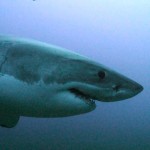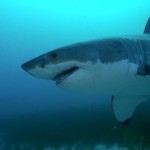‘LEFT!’ comes a cry from the top deck of the Princess II as a four-meter great white shark materializes out of nowhere. I pull on the line frantically, barely dragging the tuna head out of the reach of ‘Carlos,’ one of about fifty great whites, or white pointers, regularly spotted in the Neptune Islands. Thankfully Andrew Fox, great white guru and operator of Rodney Fox Shark Expeditions, has me positioned on the starboard corner of the back deck, so as Carlos turns from the bait he has plenty of time to avoid our shark cage without hurting himself. It’s day one of my apprenticeship, and so far the sharks are still in control.
Shark diving, especially diving with great whites, causes a fair amount of controversy. Most of the general public is absolutely terrified of sharks, even though in reality, far more people succumb to drowning than to shark attacks. In fact, as Andrew adeptly pointed out, our unfounded fear of sharks probably saves the lives of thousands of bathers worldwide every year. As soon as a dive operator starts drawing in great whites with chum and putting divers in the water with them, people seem to assume that this means the sharks will associate boats and humans with food and, of course, result in the animals going on massive man-eating rampages. Here I should say thank god for science. Much of the work that Andrew and his crew aboard the Princess II have been doing involves tagging the great whites in the Neptune Islands with satellite and acoustic tags. Their studies in conjunction with several universities have shown that chumming the waters around the Neptune Islands does not increase the number of sharks around, and the presence of boats actually seems to lead to a temporary reduction in the number of sharks in range of the acoustic base stations. Similarly, acoustic monitoring stations on many of South Australia’s most popular beaches show regular shark activity, but still, on average, only one person is killed by a shark each year in the entire country. Hopefully the data is compelling enough to convince you that these shark expeditions are not endangering the lives of swimmers and surfers around the world. If anyone’s being put in danger by the cage diving operations, it’s probably the sharks themselves.
Think about the stereotypical image of a great white shark. Mouths gaping, three rows of shiny teeth protruding from savage, bloody gums, deep black eyes that say ‘Watch out next time you get in the bath!’ That’s the so called ‘money shot’ which every underwater photographer dreams of. Now imagine what happens immediately after the shot’s taken. Nine times out of ten the shark slams headfirst into the cage, battering its nose up and often times leaving scars from the encounter. On the Rodney Fox Shark Expeditions the sharks come first, which was the focus of my weeklong apprenticeship. When I was first learning, if keeping the shark safe meant the divers didn’t get a great look at it, so be it. But as the week progressed I learned how to manipulate the bait to bring the sharks right up to the cage without hurting themselves. By day 7, the sharks were no longer running the show. Well… maybe about half the time.
Baiting the great whites to bring them in close to the cages is an excellent way of giving divers a firsthand look at these magnificent animals, but 99.999% of the time the sharks are behaving in a completely different way. After all, while they do reach six meters in length, they’re still just sharks and most of their day is spent swimming and cruising around the kelp-covered sea floor. This is where the bottom cage comes in. You might remember that in June I went cage diving with the great whites in Gansbaai, South Africa. The shark activity at the surface here in the Neptune Islands is very similar to that of Gansbaai, and probably anywhere you go to see great whites. But what’s so unique about the Rodney Fox Shark Expeditions is that they give you a glimpse into the typical lives of the great whites. Lowered down by a hydraulic crane mounted on the ship’s deck, four divers can drop down to 20 meters in a shark cage to the sea floor to observe sharks without the behavior-altering bait. I fell in love with the bottom cage. At the surface it feels as though the sharks are in it just for the chance of snagging half a bite of old tuna, but down deep where there’s no promise of food they’re genuinely curious. They swim past slowly, often less than a meter away, staring into the cage – I truly felt like I was being investigated – and disappearing into the gloom time and time again. Sometimes a shark will come give the cage a nudge, probably trying to work out what exactly this alien object could be. And why exactly are there people inside it? If you really want to see great white sharks in their natural environment, the bottom cage is the only way to do it. A week later as I fly back to the States, I’m still hungry for more great whites!


